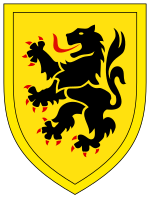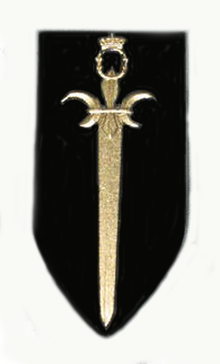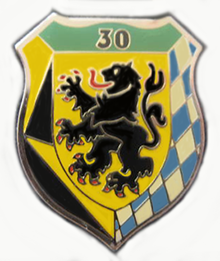Panzer Grenadier Brigade 30
|
Panzergrenadierbrigade 30 |
|
|---|---|
 Association badge |
|
| active | March 16, 1959 to March 31, 2008 |
| Country |
|
| Armed forces |
|
| Armed forces |
|
| Type | Panzer Grenadier Brigade |
| Insinuation |
|
| Staff seat | Ellwangen (Jagst) |
| Awards | Medal of Honor of the Bundeswehr-Sozialwerk e. V. in gold |
The Panzergrenadierbrigade 30 " Alb Brigade" in the Reinhardt barracks in Ellwangen was a brigade of the Army of the Bundeswehr . The brigade recently led units in Baden-Württemberg . Panzergrenadierbrigade 30 was set up in 1958 and disbanded on March 31, 2008. She was subordinate to the 10th Panzer Division until the end .
history
Prehistory as a combat group in the Army Structure 1
To assume the army structure 1 which was Panzerkampfgruppe C 4 May 12, 1958 Location of the rod in Regensburg reorganized . The Panzerkampfgruppe C 4 was subordinated to the 4th Grenadier Division . The staff of Panzerkampfgruppe C 4 moved to the Reinhardt barracks in Ellwangen as early as 1958 . Grenadier Battalion 24, which was based in Ellwangen from August 1958 , was the first unit to be set up in Coburg on July 1, 1958 . The Panzerkampfgruppe C 4 was divided into the following troops in August 1958 :
Army structure 2
To assume the army structure 2 which was the March 16, 1959 Panzerkampfgruppe C 4 in the Panzergrenadierbrigade reclassified 30th The 30th Panzer Grenadier Brigade was under the control of the 10th Panzer Division . In Army Structure 2, the brigade was divided into:
- Panzergrenadierbataillon 302 in Ellwangen (formation October 1, 1958, emerged from Grenadierbataillon 24)
- Panzerbataillon 304 in Münsingen (Württemberg) (listed on November 17, 1960)
- Panzerartilleriebataillon 305 in Donauwörth (listed on January 1, 1964, emerged from field artillery battalion 285, listed on December 1, 1958)
- Panzerpionierkompanie 300 (listed on December 1, 1959)
- 3rd / Supply Battalion 306 (listed on December 1, 1959 from Heavy Repair Company 502)
- Reconnaissance platoon of the headquarters company (set up October 1, 1962, renamed to Panzer Reconnaissance Platoon 300 on October 1, 1971 and independent unit, subordinated to the 10th Panzer Reconnaissance Battalion from October 1, 1971)
- Panzerjägerkompanie 300 in Ingolstadt (list on May 1, 1968 in Ellwangen- Jagst )
- Panzerbataillon 284 in Dornstadt (until October 4, 1968 Panzergrenadierbataillon 281 and subordination to Panzergrenadierbrigade 28 )
Army structure 3
Panzerbataillon 284 ( Münsingen (Württemberg) ) was renamed Panzerbataillon 304 in 1970. The tank battalion 104 in Amberg regrouped in October 1971 to the tank battalion 303 and at the same time switched from the Panzergrenadierbrigade 10 to Panzerbrigade 30 with relocation to the new location in Heidenheim (Middle Franconia) . By 1971 the supply battalion 306 was divided: the 3rd company became an independent repair company 300; the supply company was formed until 1974 from the transport company (name until September 30, 1971) and the supply company (name on October 1, 1971) of the supply battalion 306. The Panzer Reconnaissance Train 300 moved from Ingolstadt to Ellwangen in July 1979 and was once again incorporated into the headquarters company.
Army structure 4
On April 1, 1981, Panzer Brigade 30 reorganized into Panzergrenadierbrigade 30. For this purpose, the armored infantry battalions 301 and 303 were reorganized. The tank battalion 304 (old) was disbanded and the tank battalion 303 was renamed 304.
The brigade comprised around 3,150 soldiers in the peace structure in the autumn of 1989 . The planned growth force in the case of defense was around 3550 men . For nursery which was convened by reservists and the mobilization of non-active units provided. At the end of Army Structure 4 in autumn 1989, the brigade was still part of the 10th Panzer Division and was roughly divided into the following troop units :
-
 Staff / Staff Company Panzergrenadierbrigade 30, Ellwangen an der Jagst
Staff / Staff Company Panzergrenadierbrigade 30, Ellwangen an der Jagst
-
 Panzerjägerkompanie 300, Ellwangen
Panzerjägerkompanie 300, Ellwangen -
 Panzer Pioneer Company 300, Ellwangen
Panzer Pioneer Company 300, Ellwangen -
 Supply company 300, Ellwangen
Supply company 300, Ellwangen -
 Repair company 300, Ellwangen
Repair company 300, Ellwangen -
 Panzergrenadierbataillon 301 (partly active), Ellwangen
Panzergrenadierbataillon 301 (partly active), Ellwangen
-
 302 Panzer Grenadier Battalion, Ellwangen
302 Panzer Grenadier Battalion, Ellwangen -
 Panzergrenadierbataillon 303, Ellwangen (cadre since October 1988 as a troop test)
Panzergrenadierbataillon 303, Ellwangen (cadre since October 1988 as a troop test)
-
 Panzer Battalion 304, Heidenheim
Panzer Battalion 304, Heidenheim
-
 Panzerartilleriebataillon 305, Donauwörth
Panzerartilleriebataillon 305, Donauwörth
-
From February 1989 to October 1991, Panzergrenadierbrigade 30 tested all three models as the only major unit of the army in the troop trial "cadre and rapid growth", of which model 3 was then selected for army structure 5 .
Army structure 5 until disbandment
Between 1992 and 1994, the brigade underwent major restructuring to take on the new structure. All three armored infantry battalions 301, 302 and 303, the armored artillery battalion 305 and all independent companies with the exception of the staff and the armored engineer companies were dissolved. In return, the armored infantry battalion 294 in Stetten and the armored artillery battalion 285 in Münsingen (established in 1975 in Donauwörth from former parts of armored brigade 28 and 29 ), as well as the non-active armored infantry battalion 282 (main unit was Panzergrenadier battalion 294, and the non-active armored battalion 294 from 1992) and the inactive armored battalion was Panzer Battalion 304). Both could quickly grow up to full strength through the use of reservists and the division of the main units. The brigade is also responsible for the local medical center 504, the non-active field replacement company 300, the still existing tank pioneer company 300 and the non-active tank reconnaissance company 300 ( Ebern ), which has been spun off from the headquarters company .
In April 1993 it was given the nickname "Alb Brigade" as a reference to the home of the brigade, the Swabian Alb and the Franconian Alb .
In 1995, 1997 and 2000 the IFOR and SFOR brigade provided forces. The Panzer Grenadier Brigade 30 has been training the SFOR contingents since 1998. In 1999 the brigade trained the crisis reaction forces from the II Corps to carry out their crisis reaction tasks. In 2002 the armored infantry battalions 352 and 362 from Mellrichstadt and the armored battalion 363 from Külsheim were integrated into the brigade. In 2003 the armored artillery training battalion 345 from Kusel was incorporated . In 2003 the brigade provided forces for the 6th contingent in SFOR, KFOR, ISAF and Operation Allied Harmony. In 2004 the Panzergrenadierbataillon 282, the Panzer battalions 284 and 304 and the Panzer Reconnaissance Company 300 were disbanded. The 285 Panzer Artillery Battalion left the brigade in 2004. In 2005, forces were again provided for the 4th ISAF deployment contingent in Kabul , the 8th ISAF deployment contingent and the 11th KFOR deployment contingent in Kosovo . In 2006 the armored infantry battalion 352 in Mellrichstadt, the armored battalion 363 in Külsheim and the armored pioneer company 300 in Külsheim were decommissioned. The brigade was disbanded on March 31, 2008. The tank artillery training battalion 345 (Kusel), which was subordinated to January 1, 2003, was previously subordinated to the Army Brigade. The Panzergrenadierbataillon 294 ( Stetten am kalten Markt ) and the field replacement company 300 ( Ellwangen ) were decommissioned with the brigade. The last order of the Panzer Grenadier Brigade 30 was the preparation of the defense readiness in a crisis, the implementation and support of national and territorial operations as well as the implementation of peacekeeping, peace-making and humanitarian operations.
Shortly before it was dissolved, the Alb Brigade received the Medal of Honor from the Bundeswehr-Sozialwerk e. V. in gold for their many years of social commitment. The godparent community of the brigade was Königsbronn since September 1999 . The brigade maintained partnership relations with the 3rd Panzer Grenadier Brigade from Mautern an der Donau (Austria).
Commanders

The following officers led the brigade (rank at handover of command). As a rule, after some time, the commanders were appointed brigadier general:
| No. | Surname | Beginning of the appointment | End of appointment |
|---|---|---|---|
| 19th | Colonel Joachim Pollok (brigade leader only) | 28 Sep 2007 | 31 Mar 2008 |
| 18th | Colonel Josef Blotz | 2005 | 28 Sep 2007 |
| 17th | Colonel Hans-Christoph Ammon | 2003 | 2005 |
| 16 | Colonel Klaus Feldmann | 1998 | 2003 |
| 15th | Colonel Jan Oerding | Oct. 1, 1995 | 1998 |
| 14th | Brigadier General Klaus Hartmann | Oct 1, 1993 | Sep 30 1995 |
| 13 | Brigadier General Christian Meyer-Plath | Apr 1, 1989 | Sep 30 1993 |
| 12 | Colonel Konrad Bader | Apr 1, 1986 | 31 Mar 1989 |
| 11 | Colonel Klaus Naumann | Apr 1, 1984 | 31 Mar 1986 |
| 10 | Colonel Arno Schäfer | 25 Sep 1981 | 31 Mar 1984 |
| 9 | Colonel Horst Albrecht | Oct. 1, 1979 | Sep 24, 1981 |
| 8th | Colonel Kurt-Josef Veeser | 17th Mar 1978 | Sep 30 1979 |
| 7th | Colonel Karl-Eberhard Grumer | Oct. 1, 1975 | 16. Mar. 1978 |
| 6th | Brigadier General Michael Greipl | Oct. 1, 1970 | Sep 30 1975 |
| 5 | Brigadier General. Günther-Joachim Rothe | Oct. 1, 1967 | Sep 30 1970 |
| 4th | Colonel Rainer Schwartz | Jan 15, 1966 | Sep 30 1967 |
| 3 | Colonel Wilhelm Thomas | Oct. 1, 1963 | Jan. 14, 1966 |
| 2 | Brigadier General Wolfgang Köstlin | Jun 16, 1960 | 30 Sep 1963 |
| 1 | Colonel Werner Drews | Jun 1, 1958 | Jun 15, 1960 |
Association badge
The blazon of the association badge for the uniform of the members of the Panzergrenadierbrigade 30 read:
- Gold bordered , in gold a black, red-armored and red-tongued lion .
The lion was the Swabian Staufer lion , which appeared similarly in the coat of arms of Baden-Württemberg . The association badges of the division and the subordinate brigades were identical except for the shelves . In the tradition of the Prussian color sequence , the association badge of the Panzergrenadierbrigade 30 was given a yellow border as the “third” brigade of the division.
Since the badges of the division's brigades differed only slightly, the internal badge of the staff or the staff company pars pro toto was occasionally used as the brigade's "badge" instead . It showed a downward-pointing silver sword on a black shield . The internal association badge was handed over to the Ellwang Hotel " Königin Olga " in preparation for the dissolution in 2008 , because the brigade had taken on the tradition of the Grenadier Regiment "Queen Olga" (1st Württembergisches) No. 119 . An alternative (earlier) version showed the association badge on the Bavarian diamonds and the black and yellow state colors of Baden-Württemberg , as well as the number 30 in the green shield head - green was the weapon color of the Panzergrenadier troops .
Remarks
- ↑ For internal association badges , a wearing license was only officially issued around the mid-1980s. They are therefore not shown. The enumerated troop units or the "successors" standing in their tradition could, however, unofficially have already worn badges similar to a coat of arms or have officially received them from the mid-1980s. Association badges for large associations were only introduced into the troops in Army Structure 2 .
- ↑ Shown are the internal association badges, for which a wearing permit was officially granted until around the mid-1980s. Inactive units (equipment units, partially active, cadre units) are shown in italics .
- ↑ "First" Brigade: Panzer Brigade 28 (= white board). "Second" Brigade: Panzer Brigade 29 (= red board). "Third" Brigade: Panzer Grenadier Brigade 30 (= yellow board).
literature
- Frank Heinz Bauer: Welcome to this good city . Ellwangen and his soldiers in the mirror of a century. Ed .: Officer's Home Society Ellwangen. Officer's Home Society , Unteroffizierheimgesellschaft, Ellwangen 2006, DNB 988659433 (192 pages).
Web links
- City of Ellwangen - Bundeswehr. In: Website of the city of Ellwangen . 2020, accessed February 22, 2020 .
Individual evidence
- ↑ a b c d e f g h location database of the Bundeswehr in the Federal Republic of Germany as well as the training grounds used by the Bundeswehr abroad. In: Website of the Military History Research Office . Center for Military History and Social Sciences of the Bundeswehr , Military History Research Office , accessed on February 17, 2020 (For technical reasons, direct links to individual search queries or search results are not possible. Please use the “search form” to research information on the individual departments).
- ↑ a b c d e f g h Section MA 3 : BArch BH 9-30 / Panzergrenadierbrigade 30. In: Research application invenio . President of the Federal Archives , 2008, accessed on February 17, 2020 .
- ↑ Section MA 3 : BArch BH 8-4 / 4. Panzergrenadier Division. In: Research application invenio . President of the Federal Archives , 1998, accessed on February 17, 2020 .
- ↑ a b c d O. W. Dragoner (Ed.): The Bundeswehr 1989 . Organization and equipment of the armed forces of the Federal Republic of Germany at the end of the Cold War. 4th edition. 2.1 - Army. Army Office. I. Corps. II Corps. III. Corps, February 2012 (167 p., Relektiven.com [PDF; 747 kB ; accessed on February 21, 2020] First edition: 2009, overview of the series at Relict.com).
- ^ Uwe Walter: The structures and associations of the German army . 1st edition. Part 1., I. Corps: (1956-1995). Edition AVRA, Berlin 2017, ISBN 978-3-946467-32-8 , pp. 104 (260 pp.).
- ↑ Panzergrenadierbrigade 10: Panzergrenadierbrigade 30 receives medal of honor of the Bundeswehr Social Work in gold . January 23, 2008
Coordinates: 48 ° 57 '8.7 " N , 10 ° 7' 35" E


